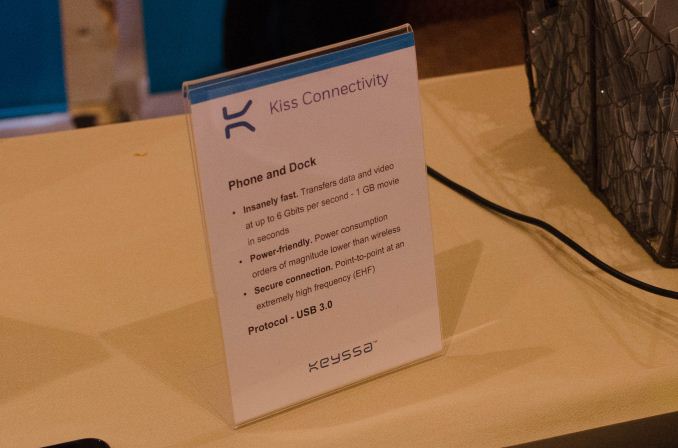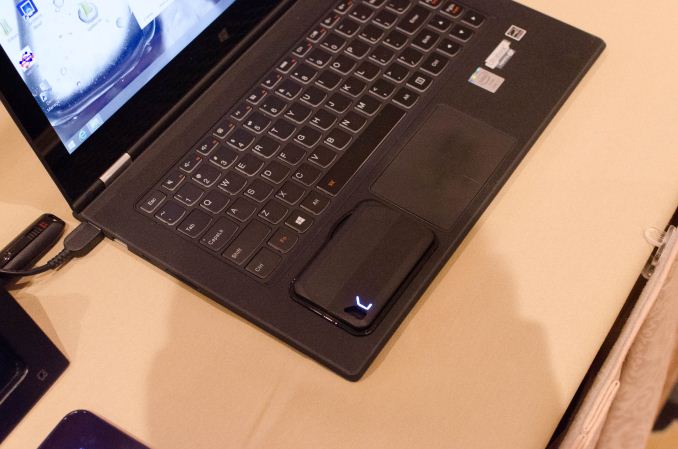A Quick Look at Keyssa: Contactless USB 3.0
by Joshua Ho on January 9, 2015 8:00 AM EST- Posted in
- Smartphones
- Mobile
- Tablets
- Trade Shows
- CES 2015
- Keyssa

While we often don’t discuss startups, at CES we found a company called Keyssa that claims to have the technology to do away with wired connectors entirely. Normally, these claims are rather misleading, but in the case of Keyssa it seems that this is quite possible as the company was formed as a spin-off from research at UCLA labs. Similar to 802.11ad, Keyssa uses the 60 GHz spectrum to deliver immense amounts of bandwidth (6 Gbps), but at much lower power levels. This lower power level does constrain the range of this technology to a few centimeters or so, similar to NFC.
In addition to the immense bandwidth, Keyssa’s connectors are relatively small and are around a millimeter thick, with a length and width similar to a microUSB 3.0 connector. It seems that this technology takes advantage of USB-IF’s media-agnostic USB standard, as in a demonstration of a prototype SSD with Keyssa’s connector the SSD appeared to be a USB drive on to a laptop with a pad for the SSD. Company representatives stated that there will be products shipping with this connector this year, and it should be interesting to see how this affects mobile devices if this technology gains traction.












18 Comments
View All Comments
edzieba - Friday, January 9, 2015 - link
After using Qi charging for a while, one of the bigger benefits (apart from the sheer convenience of charging a device by just putting it down) is the lack of any mechanical connector, so it results in very minimal wear. I can see a wireless variant of USB3 being useful simply because it means not having a small USB port that could be damaged through excessive wear or accident (drops, heavy object placed on cable near device port, etc)mr_tawan - Friday, January 9, 2015 - link
Waterproof devices could be much easier to make (and more reliable) as the weakest link is the connectors.alfredska - Friday, January 9, 2015 - link
Also, there's nothing small about a Micro USB3 plug.Samus - Saturday, January 10, 2015 - link
Yep, really becomes obvious how important wireless charging is when you consider most phones need to be charged at least once a day and the connectors become a weak link over time. I can't tell you how many Kindles, Galaxy S 2\3's and various other tablets I've replaced USB ports or power receptacles on over the years, many not even 2 years old (the life of the mobile devices contract.)djc208 - Friday, January 9, 2015 - link
Ok, I'm a little confused. If it's using the 60 GHz spectrum for transmission over short distances, what is the connector for? I'm guessing it just becomes a power/"I'm here" connection?psychobriggsy - Friday, January 9, 2015 - link
It's presumably the antenna?toe211 - Friday, January 9, 2015 - link
Antenna is in the package. No external components Differential signal in DC-to-6GHz and the Rx side derives the differential wires in the other deviceazazel1024 - Friday, January 9, 2015 - link
If they are actually connectors and that wasn't a mistake, it is a mag connector for power basically. That and considering the short distance, probably because it needs to be VERY close. 60GHz has abysmal penetration (I am kind of suprised they aren't using 27GHz, as penetration also stinks, but it is a LOT better than 60GHz).60GHz is basically stopped by a piece of paper. So even the plastic casing of a device is going to block 60GHz. You can work around this a bit for 802.11ad since it is higher power as 60GHz is also reflected pretty well, so it'll bounce of walls and other surfaces in the same room. Very low power though...little reach and little chance of reflection.
It is interesting, my concern is it'll move towards even less connectivty for devices. Hard connectors are just plain NEEDED for some things. Want to add an ethernet adapter? Plug it in. Oh...you don't have a plug, just a wireless connection...um...uh. Hmm, put a battery in the ethernet adapter...errr...hmmm.
Rather than wireless I'd rather see us move to a standardized mag connector for data and power that is thin/small/can be surface mounted. Now maybe this thing will do the exact same thing with a couple of tiny power contacts and a magnet if your "wireless USB3" device needs power...but...
Duncan Macdonald - Friday, January 9, 2015 - link
The attenuation of 60GHz is nothing like as bad as you state - it is absorbed by atmospheric oxygen with an attenuation of about 20dB/km but it is not heavily absorbed by plastic or dry paper - given a working distance of about 1cm (as in the photo) the main losses will be the antenna losses.Gigaplex - Friday, January 9, 2015 - link
You could power the Ethernet adapter with PoE, so that's not really the best example to get your point across. Besides, just use Wi-Fi in this instance.